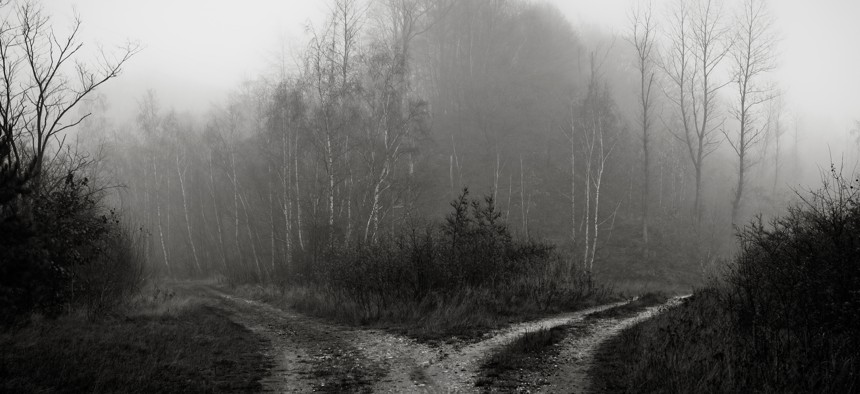How One State Tracks Down Cartographic ‘Phantoms’

Andrea Schuh/GettyImages
To improve the accuracy of its maps, the Wisconsin State Cartographer’s Office is weeding out small rural communities that no longer exist.
Phantoms are showing up on a Wisconsin map, but there’s nothing supernatural afoot. They’re labels of villages, communities, towns that today exist in name only.
For instance, folks traveling to Door County—known as the Cape Cod of the Midwest and home to lakeside resorts and fudge shops—might look at a map and decide to stop in Clyde for gas. “It’s on the map, you assume it’s there … but essentially, there’s nothing really there,” said Mike Hasinoff, a geographic information systems research analyst at the Wisconsin State Cartographer’s Office.
These phantoms hold historical value, but on modern-day maps, they’re just confusing. That’s why the Cartographer’s Office is preparing to ask the U.S. Geological Survey to update its Geographical Names Information System, the official federal repository for geographic nomenclature, using its research in the state.
The goal is not to have GNIS remove these places from maps, but rather “to adjust the maps and have these phantoms labeled as ‘historical,’” Hasinoff said, adding that the term “phantom” is one his boss, Howard Veregin, state cartographer, used. “It may have historical significance … and we don’t want to lose that.”
The Cartographer’s Office has been working for about 10 years to pinpoint unincorporated areas that “often become phantoms. They are usually small communities, often in areas of declining population and are not actively monitored by state or federal agencies like the Census Bureau,” Hasinoff wrote in a recent call for public help in identifying phantoms.
So far, the agency has identified more than 600 potential cartographic phantoms found in the GNIS database. It’s whittled those down to the likeliest ones using its “Fast Phantom Finder” method, which is based on ArcGIS.
This involved identifying properties within a quarter-mile buffer around the GNIS-defined unincorporated location—the same distance that the Wisconsin Department of Transportation uses when it provides signage for an unincorporated community that has at least 50 residents.
Then, the Cartographer’s Office pulled data from attribute tables in its Statewide Parcel Map to filter out non-residential properties and those with assessed values of improvement of less than $800. The agency used that amount to eliminate parcels with non-inhabitable improvements, such as a shed or garage.
If several properties fit the bill within the area, then the location is not a phantom, Hasinoff said. Conversely, areas with no residential parcels tend to have no residential population and no existing community, so they are potential phantoms. SCO identified 58 potential phantoms with this procedure.
Then with additional evidence from imagery or even in-person verification, the agency cut the list to 31 likely phantoms.
Hasinoff likened the process to creating a Venn diagram with data—identifying unincorporated areas and their buffers in one circle and the Parcel Map’s classifications and values in another and seeing if they intersect.
“All of these parcels have geographic data behind them to allow you to put it on top of another map,” Hasinoff said. “In the end, you’re running all these different filters, putting one more circle into your Venn diagram to allow you to come up with that one spot where all of those circles overlap in terms of what criteria are being met.”
The biggest challenge with phantoms is that sometimes in-person visits are necessary to verify that an unincorporated area is indeed not a community. To get those confirmations, Hasinoff called for crowdsourcing help in the March Wisconsin Geospatial News newsletter.
“That newsletter was a starter to say, ‘Land information officers, real estate community, geospatial community, what do you know about these places?’” he said. “They can literally ask around the office: ‘Have you heard of that place?’… There’s only so much you can do by yourself and the limits of what we can do with the parcel data.”
As of June 16, the map has gotten more than 2,500 views.
Although the main goal is more accurate maps, Hasinoff said history buffs may find value in the research. For instance, Lapham Junction, an old railway wye (triangular junction) no longer has residents, but a land information officer who responded to the crowdsourcing call went there with a metal detector and found railway nails, Hasinoff said.
The critical software is the Parcel Map, he added, noting that only a handful of states have something like it. Wisconsin Act 20, the biennial state budget for 2013-15, created statutory directives for state and local governments to coordinate on the development of a statewide digital parcel map using GIS technology, according to the state’s Department of Administration.
Although Cartographer’s Office created the phantoms map with the idea of other places replicating it, Hasinoff said it could be hard without existing digital parcel maps or data.
Stephanie Kanowitz is a freelance writer based in northern Virginia.
NEXT STORY: 3 Simple Steps to Improve Digital Government





